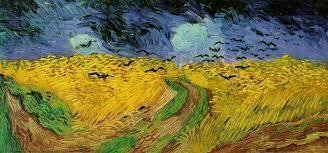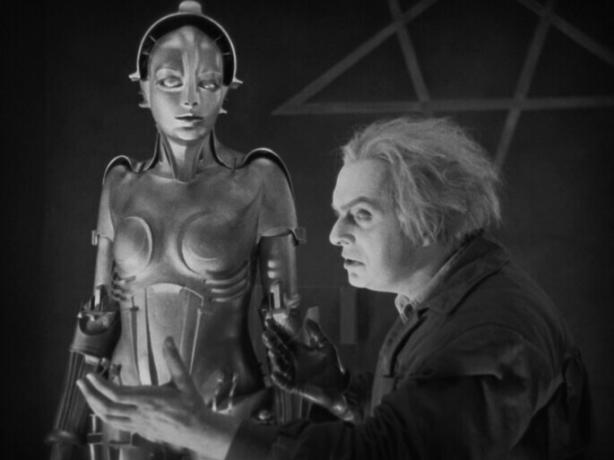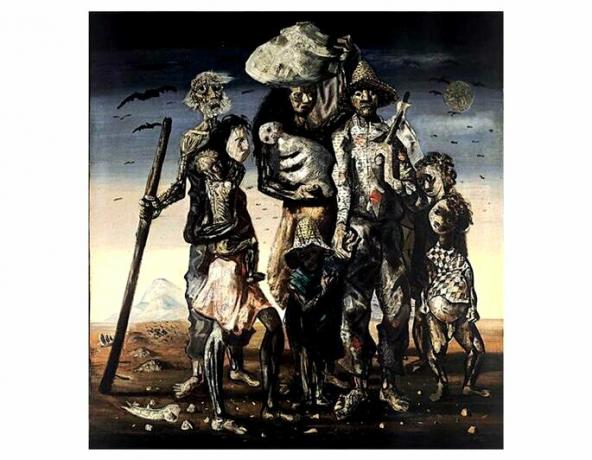The expressionist movement was one of the European vanguards that emerged at the beginning of the 20th century. Important in the context of modern art, he influenced other artists and left a great legacy for contemporary art.
Because it is a relevant topic in the history of art, addressed in contests and entrance exams, we bring you 10 questions (mostly original) for you to test and improve your knowledge.
question 1
The painter Vincent van Gogh, born in the Netherlands, is one of the great names of western art. When you painted the canvas Wheat field with crows (1890), the artist said the sentence: "They are vast expanses of wheat under stormy skies and I have had no difficulties to express the sadness and extreme loneliness."

About this artist, it is correct to say that he was the forerunner of the artistic movement:
a) baroque
b) impressionism
c) Expressionism
d) surrealism
Correct answer: c) Expressionism
Vincent van Gogh, born in Holland in 1853, had a troubled life and carried a strong emotional charge in his painting. His canvases were vigorous and conveyed a bit of his state of mind.
After his death, in 1890, his art was essential to inspire other artists to create expressionism, which had as its hallmark the appreciation of emotions.
question 2
In 1905 the artists Ernst Kirchner (1880-1938), Erich Heckel (1883-1970) and Karl Schmidt-Rottluff (1884-1976) created the first group that became one of the most important exponents of expressionism in Germany.
What was the name of that group?
a) Der Blaue Reiter (The Blue Knight)
b) Skrik (The Scream)
c) Der Sturm (The Storm)
d) Die Brücke (The Bridge)
Correct answer: d) Die Brücke (The bridge)
The founders of Die Brücke were architecture students in Dresden and chose this name, which means "bridge", as a symbol of a passage between the art they were making at the time and the art that would be made in the future. future. The inspiration came from the book "Thus Spoke Zaraturtra", by the German philosopher Friedrich Nietzsche, with the phrase "The important thing in man is that he is a bridge and not an end."
question 3
Expressionism is considered the first European avant-garde movement that sought to break with the prevailing art until then. Appearing at the end of the 19th century and beginning of the 20th century, it was closely related to its social and historical context, which brought some peculiarities and remarkable events, such as:
a) World War II and the rise of Nazism in Germany
b) World War I and the advance of industrialization
c) Cold War and the arms race
d) Neocolonialism and the invasion of territories in Africa and Asia
Correct answer: b) World War I and the advance of industrialization.
The First World War, which took place between 1914 and 1918, broke out just a few years after the first time the term expressionism was mentioned in the magazine Der Sturm (The Tempest), in 1911.
Thus, the social anxieties that already surrounded Europe, with the advance of industrialization, uncertainties and loneliness, become material for expressionism.
question 4
In Brazil, modern art was influenced by various vanguards that developed in Europe. Among them the expressionist aspect, which was shown in the production of important artists. One of these people was the creator of the work we see below, which clearly brings expressionist aspects.

What is the name of this work and its author or author?
a) The ironic woman, by Tarsila do Amaral
b) The boba, by Guiomar Novaes
c) The woman with the green hair, by Anita Malfatti
d) Lady in profile, by Mario de Andrade
e) Expressionist woman, by Candido Portinari
Correct answer: c) The woman with green hair, by Anita Malfatti.
Anita Malfatti was an artist who, at the beginning of her career, was greatly inspired by expressionism, having even studied art in Germany between 1910 and 1914, when the trend was emerging.
Woman with green hair is one of his canvases clearly inspired by the movement, created in 1916.
question 5
About expressionism, mark the CORRECT alternative:
a) It was a movement that emerged at the beginning of the 20th century, whose precursor was the French artist Pierre-Auguste Renoir.
b) It occurred mainly in painting, with exponents such as Munch, Marc Chagall and Paul Klee, not standing out in other artistic languages.
c) He valued idealized forms, with a strong aesthetic concern and the expression of appeasing feelings.
d) In addition to the plastic arts, he also developed in literature, music, architecture and especially in cinema and theater.
Correct answer: d) In addition to the plastic arts, he also developed in literature, music, architecture and especially in cinema and theater.
Cinema was one of the most important strands of expressionism, with iconic films such as The Cabinet of Dr. Caligari and Nosferatu.
question 6
(Fuvest / 2019)

This image is a reproduction of:
a) an impressionist painting, marked by loose brushstrokes and the theme of American emigration to the European continent.
b) a cubist mosaic, characterized by geometric shapes that seek to highlight the hope of those heading to foreign lands.
c) an expressionist painting, which reinforces the suffering of those who moved in a context of persecution and intolerance.
d) a surrealist panel, which sought to highlight the tormented subconscious of those who left their places of origin.
e) a futuristic painting, influenced by references to technological modernization characteristic of the first half of the 20th century.
Correct answer: c) an expressionist painting, which reinforces the suffering of those who moved in a context of persecution and intolerance.
In the creation of this work that portrays the suffering of people who leave their country of origin in terrible conditions, Lasar Segall was inspired by expressionism. This artistic current stood out for its concern to represent intense emotions, such as anguish and despair.
question 7
(UPE/2014)
Note the following image:

It portrays one of the most outstanding productions of German expressionism in the first decades of the 20th century. About this artistic movement, it is NOT correct to say that
a) it was an avant-garde movement that emerged in the first decade of the twentieth century.
b) had the labor movement as its main influence, based on the Soviet cinema of David W. Griffith.
c) manifested itself basically in painting, literature and theater.
d) in cinema, his main concerns were the individual, his personal concerns and the drama of a society devastated by war.
e) his most outstanding film productions were Dr Caligari's Cabinet, Nosferatu and Metropolis.
Correct answer: b) had the labor movement as its main influence, based on the Soviet cinema of David W. Griffith.
Expressionism was not based on the labor movement and Soviet cinema. By the way, filmmaker David W. Griffith was not Soviet, but American, being responsible for great innovations in cinema and also for the creation of the film. The birth of a nation, considered extremely racist.
The other alternatives present true statements.
question 8
The European vanguards developed at a time of great transformations in the world, in which societies experienced wars, industrial development and a growing sense of inadequacy.
The first artistic current considered one of these vanguards was expressionism. About the motivations and characteristics of this movement, we can say.
a) It arose from a desire for change, in which speed and progress are exalted, with Giacomo Balla as its exponent.
b) Conceived by Tristan Tzara in 1916, it had an illogical character and questioned war through spontaneity and free expression.
c) It was based on the subconscious world, valuing impulsive and dreamlike expressions. It was represented by Paul Cézanne.
d) It sought to break with impressionist art, making a counterpoint to the "luminous" style of the strand. It arises from the post-impressionists and subverts the way of producing art.
Correct answer: d) It sought to break with impressionist art, making a counterpoint to the "luminous" style of the strand. It arises from the post-impressionists and subverts the way of producing art.
Expressionism deepens some impressionist techniques, but opposing the positive and optimistic character of the impressionists. Thus, expressionism seeks to expose the strong and distressing emotions of individuals.
question 9
The Brazilian Candido Portinari was one of the artists who used expressionism as inspiration for his canvases, as is the case of the painting below:

About the work, mark the INCORRECT alternative:
a) It is called "Retirantes" and portrays a family in search of better living conditions.
b) It is part of the collection of the Museu de Arte de São Paulo (MASP) and was painted in 1944.
c) It has a somber appearance, showing malnourished figures, a portrait of the extreme poverty that plagued Brazil in the first half of the 20th century.
d) It exhibits a dreamlike character, with deformed figures inserted in an unreal scene, projected only in the artist's unconscious.
Correct answer: d) It exhibits a dreamlike character, with figures inserted in an unreal scene, projected only in the artist's unconscious.
All alternatives present correct information, except answer D. The painting was not thought of as a "dream" or an unrealistic scene. And yes, it displays the harsh reality of the country, albeit in a stylized and caricatured way, with deformed figures.
question 10
Emerged at the beginning of the 20th century, the expressionist movement had as representatives, whether in Europe or in Brazil, the following artists:
a) Candido Portinari, Max Ernest and Albrecht Dürer
b) Franz Marc, Wassily Kandinsky and Egon Schiele
c) Vincent van Gogh, Gustav Klimt and Lasar Segall
d) Henri Matisse, Renoir and Rembrandt
e) Anita Malfatti, Cezanne and Caravaggio
Correct answer: b) Franz Marc, Wassily Kandinsky and Egon Schiele
These three artists were exponents of expressionism, contributing to its development in modern art.
You may also be interested:
- Exercises on European Vanguards
- Exercises on the Week of Modern Art
- Arts questions that fell on the Enem
- Questions on Surrealism and Dadaism (with comments)
AIDAR, Laura. 10 exercises on expressionism to test your knowledge.All Matter, [n.d.]. Available in: https://www.todamateria.com.br/exercicios-sobre-o-expressionismo/. Access at:
See too
- Expressionism
- Exercises on European Vanguards
- Modern Art
- European Vanguards
- The 9 most important artistic movements of the 20th century
- world famous paintings
- Impressionism
- Cubism



